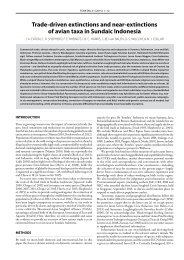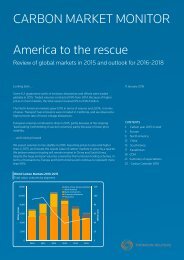Emissions Trading Worldwide
1TbjEHd
1TbjEHd
You also want an ePaper? Increase the reach of your titles
YUMPU automatically turns print PDFs into web optimized ePapers that Google loves.
plans to the EPA indicating how each state intends to implement<br />
the CPP. If enough states express interest, it is possible that these<br />
submissions will ultimately lead to the formation of a national carbon<br />
market.<br />
“While states are not obliged to implement<br />
an ETS, the EPA will allow states to form<br />
linked or multi-state programs, regardless<br />
of whether they are neighbors or share a<br />
common electricity market.”<br />
Conclusion<br />
The ETS concept originated in the U.S., and RGGI is one of the first<br />
ETS in the world to address carbon dioxide emissions. Informed<br />
by a robust stakeholder process, the RGGI states intend to maintain<br />
their leadership role by updating the RGGI program to address<br />
the CPP’s requirements, provide a model for other states, allow for<br />
an expanded carbon market, and support economic growth. The<br />
EPA’s finalization of the CPP, including support for the creation of<br />
RGGI-like systems in other U.S. states, represents significant progress<br />
for RGGI and U.S. climate policy.<br />
ICAP members may be particularly interested in how discussions<br />
about expanding emissions trading beyond RGGI and<br />
California are informed by technical knowledge on ETS design.<br />
From an academic perspective, expansion would be a positive<br />
development as it is well known that larger markets can deliver<br />
more emissions reductions at lower costs. On the other hand,<br />
issues that have been discussed in the context of linking may<br />
pose challenges, particularly when one considers the diversity of<br />
U.S. states with respect to size and power generation resources.<br />
While states are not obliged to implement an ETS, the EPA will<br />
allow states to form linked or multi-state programs, regardless of<br />
whether they are neighbors or share a common electricity market.<br />
Therefore, the size and configuration of any ETS that may be used<br />
to comply with the CPP is uncertain and will remain so for some<br />
time. It will be a busy year for regulators, stakeholders, and academics<br />
that wish to provide input, with resources such as ICAP’s<br />
annual reports providing valuable evidence of the viability and<br />
adaptability of <strong>Emissions</strong> <strong>Trading</strong> Systems.<br />
“Informed by a robust stakeholder<br />
process, the RGGI states intend to maintain<br />
their leadership role by updating<br />
the RGGI program to address the CPP’s<br />
requirements, provide a model for other<br />
states, allow for an expanded carbon<br />
market, and support economic growth.”<br />
international carbon action partnership<br />
15




